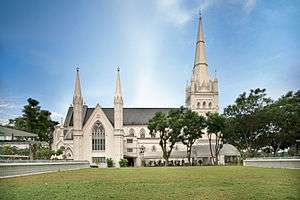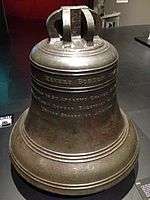St Andrew's Cathedral, Singapore
| St Andrew's Cathedral | |
|---|---|
 | |
 St Andrew's Cathedral | |
| 1°17′31.5″N 103°51′7.3″E / 1.292083°N 103.852028°ECoordinates: 1°17′31.5″N 103°51′7.3″E / 1.292083°N 103.852028°E | |
| Location | 11 St Andrew's Road |
| Country | Singapore |
| Denomination | Anglican |
| Churchmanship | Low church |
| Website | http://cathedral.org.sg/ |
| History | |
| Status | Cathedral |
| Consecrated |
10 September 1838 (first church) 25 January 1862 (current building) |
| Architecture | |
| Functional status | Active |
| Heritage designation | National Monument[1][2] |
| Designated | 1973 |
| Architect(s) | Ronald MacPherson (current building) |
| Style | Gothic Revival |
| Administration | |
| Parish | St Andrew |
| Diocese | Singapore |
| Clergy | |
| Vicar(s) | Revd Canon Terry Wong[3] |
| Dean | Rt Revd Rennis Ponniah |
| Designated | 28 June 1973 |
Saint Andrew's Cathedral (Chinese: 圣安德烈座堂; pinyin: Shèng Āndéliè Zuòtáng; Malay: Katedral St Andrew; Tamil: செயிண்ட் ஆண்ட்ரூ கதீட்ரல்) is an Anglican cathedral in Singapore, the country's largest cathedral. It is near City Hall, MRT Interchange in the Downtown Core, within the Central Area in Singapore's central business district. It is the Cathedral church of the Anglican Diocese of Singapore and the mother church of her 27 parishes and more than 55 congregations. A church existed on the site since 1836, the current church however was built in 1856–1861. The logo of the Cathedral is the St Andrew's Cross. 2006 marked the 150th anniversary of the St Andrew's Church Mission which was initiated in 1856.
History
A piece of land between Hill Street and North Bridge Road was allocated by Sir Stamford Raffles in his Town Plan of 1822 for the siting of an Anglican church, however, construction of the church did not begin until funds were raised by the community in 1834.[4] The church was named Saint Andrew after the patron saint of Scotland in honour of the Scottish community who had donated to the building fund.[5]
First church
The first Saint Andrew's Church was designed by George Drumgoole Coleman in the neo-classical style. The foundation stone was laid on 9 November 1835, and the building constructed by 1836. The first church service was conducted on 18 June 1837 by the first chaplain, Reverend Edmund White, and the church was consecrated on 10 September 1838 by Bishop Daniel Wilson of Calcutta.[6]
After complaints that the church resembled a "Town Hall a College or an Assembly Room", a spire was added by John Turnbull Thomson in 1842. The spire however was built without a lightning conductor installed, and the church suffered two lightning strikes in 1845 and 1849. It was then declared unsafe and closed in 1852, and subsequently demolished in 1855.[4]
The church had a church bell known as the Revere Bell, named after Mrs Maria Revere Balestier, the wife of American Consul Joseph Balestier, who donated it in 1843.[6]
Second church
The construction of a second church was initiated by the then Governor of the Straits Settlements William Butterworth. Colonel Ronald MacPherson, the Executive Engineer and Superintendent of convicts, designed the new church in the Gothic Revival style. The tower was originally designed to be twice the height of the built tower and without a spire, however during the construction, it was found that foundation may not support such a heavy structure, and a lighter spire was used instead.[7] The plan was also simplified so that it may be more easily built by the Indian convict labourers commonly used in building construction in early Singapore. John Bennet was the engineer responsible for the construction. After MacPherson was transferred to Malacca, the completion of the building was overseen by Major John F. A. McNair, John Bennett and W. D. Bayliss.[5]
The Rt Rev. Dr Daniel Wilson, Lord Bishop of Calcutta, laid the foundation stone on 4 March 1856, and the building was completed in 1861. The first service was held on 1 October 1861. Dr George Cotton, who succeeded Bishop Wilson, had the honour of consecrating the church on 25 January 1862.[6]
The Saint Andrew's Mission was initiated on 25 June 1856, and the first Anglican evangelical outreach in Singapore was launched from the church.[8]
Consecration as cathedral

In 1869, the church was transferred from the Diocese of Calcutta to the Diocese of Labuan and Sarawak. In 1870, Archdeacon John Alleyne Beckles consecrated it as the Cathedral Church of the United Diocese.[9]
The Revere Bell was replaced by a chime of bells in 1889. The Revere Bell is currently placed in the National Museum of Singapore.[5] The Cathedral is owned by the Synod of the Diocese of Singapore, and the first Anglican bishop, The Right Reverend J. Ferguson-Davie, was appointed in 1909. In 1942, shortly before the fall of Singapore to the Japanese, the cathedral served as an emergency hospital. A Memorial Hall dedicated to those who died in the Second World War was added in 1952.[9]
The north and south transepts of the cathedral was originally built as porches for carriages. Both transepts have been extended to provide halls, meeting rooms and offices – the North Transept in 1952, the South Transept 1983.[10]
Saint Andrew's Cathedral was gazetted as a national monument on 28 June 1973.[5]
A project to extend the building was initiated in 2003. An archaeological excavation was conducted on its grounds in 2004 by the National University of Singapore before building commenced.[11] The extension, called the Cathedral New Sanctuary, was completed in November 2005. It was largely built underground to comply with conservation guidelines for a gazetted national monument, and features a new worship hall within two underground levels of new floor space.[6]
Architecture
The existing cathedral was designed in a Neo-Gothic architectural style, and was finished with Madras chunam. The architect MacPherson is said to have drawn inspiration for aspects of the design from Netley Abbey, a ruined thirteenth century church in Hampshire, England.[7] The piers of the nave of Saint Andrew's closely resemble the surviving piers at Netley.
Three stained glass windows located at the apse are dedicated to three figures in Singapore's early colonial history and who are represented on the windows by their coats of arms. The window at the centre is dedicated to Sir Stamford Raffles, the windows on the left to John Crawfurd, the first major Resident of Singapore, and the windows on the right to Major General William Butterworth, the governor who initiated the construction of the second church building.[12] However, the original stained glass windows were damaged during the Second World War.[7][13] MacPherson is remembered in the grey and red granite memorial monument surmounted by a Maltese cross in the grounds, and by the stained glass window over the west door. Jalan Klapa was also renamed MacPherson Road in his honour. The gallery at the West end was not part of MacPherson's plan but added after the Cathedral opened. It has the only decorated elements in the church, with foliated pillars and pilasters, and crocketed arches.[7]
Three objects in the Saint Andrew's Cathedral symbolise the affiliation of the Church with the Anglican Communion in England and its allegiance to the worldwide See of Canterbury.[12] The Canterbury Stone, set in a pillar by the lectern and bearing a bronze replica of the Canterbury Cross, was sent from Canterbury Cathedral in 1936.[14] The Coventry Cross, on the column supporting the pulpit, is made from three silver-plated iron nails from the ruins of the 14th century Coventry Cathedral destroyed by bombing during the Second World War.[13] The Coronation Carpet in the Epiphany Chapel comes from the carpet that was used in the Coronation of Queen Elizabeth II in Westminster Abbey.[12]
St Andrew's Cathedral Choir
The St Andrew's Cathedral Choir is the oldest musical institution in Singapore. The choir director is Mr. Lim Chin Kai.[15] Susan Siaw and Lucille Quek are the choir representatives of the 46 members choir. There is also a children's choir. The choir director is Connie. Members of the St. Andrew’s Cathedral Choir are very much members of the St. Andrew’s Cathedral community.
Gallery
- Aerial photograph
- The arched entrance of the Cathedral.
- The extended pinnacles to the west of the Cathedral.
- Exterior view

See also
References
- ↑ Republic of Singapore. Government Gazette. Subsidiary Legislation Supplement. (6 July 1973). The Preservation of Monuments Order 1973 (S228/1973, p. 377). Singapore: [s.n.]. Call no.: RSING 348.5957 SGGSLS
- ↑ "Preserving our heritage: Wayang Street is the focal point". The Straits Times. National Library Board archives. 2 August 1973. p. 12.
- ↑ "Staff Directory". St Andrew's Cathedral website.
- 1 2 Jane Beamish; Jane Ferguson (1 December 1985). A History of Singapore Architecture: The Making of a City. Graham Brash (Pte.) Ltd. pp. 37–39. ISBN 978-9971947972.
- 1 2 3 4 "Saint Andrew's Cathedral". Roots. National Heritage Board.
- 1 2 3 4 "St Andrew's Cathedral". Singapore Infopedia. National Library Board, Singapore.
- 1 2 3 4 Jane Beamish; Jane Ferguson (1 December 1985). A History of Singapore Architecture: The Making of a City. Graham Brash (Pte.) Ltd. pp. 48–51. ISBN 978-9971947972.
- ↑ "1856". St Andrew's Cathedral, Diocese of Singapore.
- 1 2 Hooi, Christopher (1982). National Monuments of Singapore. National Museum. p. 29.
- ↑ "Our Beginning". St Andrews Cathedral, Diocese of Singapore.
- ↑ Lim, Tse Siang. (2012). 14th Century Singapore: The Temasek Paradigm (Master of Arts thesis). Retrieved from ScholarBank@NUS.
- 1 2 3 Singapore's 100 Historic Places. National Heritage Board. Archipelago Press. 2002. p. 51. ISBN 981-4068-23-3.
- 1 2 "Tour of Cathedral Building". St Andrew's Cathedral, Diocese of Singapore. Archived from the original on 3 November 2002.
- ↑ "Canterbury Stone for Singapore". The Straits Times. 9 January 1936. p. 12.
- ↑ http://www.livingstreams.org.sg/sac/directory.html
- Norman Edwards, Peter Keys (1996), Singapore – A Guide to Buildings, Streets, Places, Times Books International, ISBN 9971-65-231-5
- Insight City Guide: Singapore
External links
| Wikimedia Commons has media related to Saint Andrew's Cathedral, Singapore. |